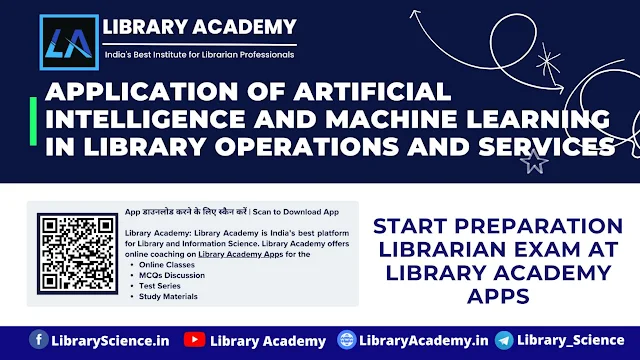Application of Artificial Intelligence and Machine Learning in Library Operations and Services
Artificial Intelligence (AI) and Machine Learning (ML) have the potential to significantly transform library operations and services, making them more efficient, user-friendly, and tailored to the needs of patrons. Here are some applications of AI and ML in library settings:
i. Automated Metadata Generation: AI algorithms can be employed to analyze content and generate metadata, making the cataloging process faster and more accurate.
ii: Automated Classification: ML models can learn to classify materials based on their content, allowing for improved organization and search capabilities.
#02: Information Retrieval:
i. Recommendation Systems: AI-powered recommendation systems can suggest relevant books, articles, or other resources based on user preferences, borrowing history, and behavior patterns.
ii. Semantic Search: ML algorithms can enhance search engines by understanding the context and meaning behind queries, improving the accuracy and relevance of search results.
#03: User Services:
i. Chatbots and Virtual Assistants: AI-driven chatbots can assist users with general inquiries, guide them through library resources, and provide real-time support.
ii. Personalized Learning Paths: ML can help create personalized learning paths for users, recommending resources and activities based on their individual needs and learning styles.
#04: Collection Development:
i. Predictive Analytics: ML algorithms can analyze usage patterns, circulation data, and user feedback to predict future demand for specific materials, aiding in collection development decisions.
ii. Content Curation: AI tools can assist in curating collections by identifying relevant and high-quality resources based on user interests and preferences.
#05: Preservation and Conservation:
i. Condition Monitoring: AI can be used to monitor the condition of physical materials, predicting potential issues and helping with proactive preservation efforts.
ii. Digitization Planning: ML algorithms can assist in prioritizing materials for digitization based on factors such as historical significance, demand, and preservation needs.
#06: Data Management and Analysis:
i. Usage Analytics: AI can analyze usage data to provide insights into the popularity of specific resources, helping libraries make informed decisions about resource allocation.
ii. Fraud Detection: ML algorithms can assist in identifying fraudulent activities, such as unauthorized access or misuse of library resources.
iii. Accessibility Services: Text-to-Speech and Speech-to-Text: AI technologies can enhance accessibility by providing text-to-speech and speech-to-text capabilities, making resources more accessible to individuals with visual or auditory impairments.
#07: Security: Anomaly Detection: AI can be employed to detect unusual patterns in user behavior, helping identify security threats or unauthorized access.
Implementing AI and ML in library operations requires careful consideration of ethical considerations, user privacy, and the potential biases in algorithms. However, when implemented thoughtfully, these technologies can greatly enhance the efficiency and effectiveness of library services.
Download Library Academy Apps to join courses: Click Here
Join Library Academy Telegram Channel: Click Here


Post a Comment